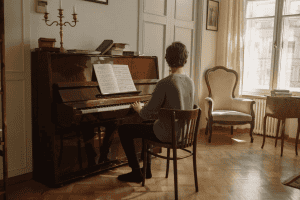Johannes Brahms is a giant of western classical music. His contributions to music are extensive and profound, particularly his piano works. In this article, we will explore eight of the most famous Brahms pieces for piano and offer insight into their significance, technical demands, and interpretive qualities.
No matter whether you are a beginner looking to dip your fingers into the works of Brahms or a more advanced student looking for your next challenge and inspiration, you are sure to find something to love in these piano pieces. Let’s take a look!
- Fall in love with the music - Learn your favorite songs, at a level suitable for you.
- Enjoy interactive piano lessons - Explore courses covering music theory, technique chords & more.
- Get real-time feedback - Skoove's feedback tells you what went well and what needs practice.

Overview of Johannes Brahms
Johannes Brahms was born on May 7, 1833, in Hamburg, Germany. A prodigious talent, he began playing piano at a young age and later studied composition and music theory. His career was marked by a deep engagement with the musical traditions of his time, particularly those of Beethoven, Schubert, and Schumann, whom he deeply admired.
Brahms is often regarded as one of the “Three B’s” of classical music, alongside Bach and Beethoven. His works span various genres, including symphonies, concertos, chamber music, and solo piano pieces. He was a master of counterpoint and development, creating music that is both technically demanding and deeply expressive.
The appeal of Brahms’ piano music
Brahms’ piano compositions are known for their expressive range, combining lyrical melodies with complex rhythms and harmonies. His music often explores themes of introspection, nostalgia, and passion, resonating with audiences and performers alike. His music is readily available in classical piano sheet music.
The technical challenges present in his piano pieces also offer pianists the opportunity to develop their skills and interpretative abilities, making Brahms’ works both a joy and a challenge to play.
8 essential Brahms piano pieces
Intermezzo in A major, Op. 118 No. 2
The Intermezzo in A Major, Op. 118 No. 2, is one of Brahms’ most beloved piano works. It is part of a set of six pieces that reflect Brahms’ mature style, characterized by introspective melodies and rich harmonic language.
This Intermezzo is marked by its lyrical, song-like quality, with a gentle yet expressive melody that floats over a delicate accompaniment. The piece allows pianists to explore Brahms’ nuanced use of dynamics and phrasing, requiring a sensitive touch and an understanding of the work’s emotional depth.
Known to be one of Brahm’s most iconic pieces, here’s a virtual guide on finger movements when playing the Intermezzo, Op.118 No.2.
Rhapsody in G minor, Op. 79 No. 2
The Rhapsody in G Minor, Op. 79 No. 2, is a dramatic and virtuosic piece that showcases Brahms’ ability to blend lyrical themes with powerful, rhythmic elements. This piece is characterized by its bold opening theme, which contrasts with a more lyrical middle section.
The technical demands of the Rhapsody include rapid passages, wide leaps, and dynamic contrasts, making it a challenging piece for pianists. However, its passionate and expressive nature makes it a rewarding piece to perform, providing a showcase for both technical skill and interpretative depth.
Variations on a Theme by Paganini, Op. 35
The Variations on a Theme by Paganini, Op. 35, are considered some of the most technically demanding works in the piano repertoire. Divided into two books, these variations are based on Niccolò Paganini’s 24th Caprice for solo violin.
Brahms’ treatment of the theme involves intricate variations that test a pianist’s technical prowess, including rapid finger work, wide-ranging arpeggios, and complex rhythms. Despite the technical challenges, these variations are also musically rewarding, offering a rich exploration of Brahms’ inventive use of harmony and texture.
Capriccio in B minor, Op. 76 No. 2
The Capriccio in B Minor, Op. 76 No. 2, is part of a set of eight pieces that highlight Brahms’ versatility as a composer for the piano. This particular Capriccio is noted for its fiery and impassioned character, with a driving rhythm and bold harmonic language.
The piece requires a strong sense of rhythm and a capacity for dramatic expression, making it a favorite among pianists. Its dynamic range and emotive power also make it a compelling piece for audiences.
Ballades, Op. 10
The Ballades, Op. 10, are a set of four pieces that showcase Brahms’ storytelling ability through music. Each Ballade is distinct in character, ranging from the lyrical and introspective to the dramatic and forceful.
The first Ballade, inspired by a Scottish ballad, features a haunting melody and rich harmonic textures. The second is more playful, with a lighter, more dance-like feel. The third Ballade is lyrical and expressive, while the fourth is characterized by its dark, brooding quality.
These pieces are not only technically challenging but also require a deep interpretative understanding to convey their emotional narratives.
Intermezzi, Op. 117
The Intermezzi, Op. 117, are three pieces that reflect Brahms’ mature, introspective style. These works are often described as “lullabies of my sorrow” by Brahms himself, reflecting their tender and reflective character.
The first Intermezzo is particularly well-known for its beautiful, song-like melody and rich harmonies. The second Intermezzo explores more complex textures and rhythms, while the third is more introspective, with a gentle, contemplative feel.
These pieces are ideal for pianists looking to explore Brahms’ more lyrical and expressive side.
Sonata No. 3 in F minor, Op. 5
The Sonata No. 3 in F Minor, Op. 5, is one of Brahms’ most ambitious piano works, both in scale and complexity. This five-movement sonata is notable for its dramatic contrasts and structural innovations, including a poetic slow movement and a lively scherzo.
The sonata requires not only technical skill but also a deep interpretative understanding as it explores a wide range of emotions and musical ideas. Its finale, a powerful rondo, brings the work to a dramatic and triumphant conclusion.
Piano Quartet in G minor, Op. 25 (Gypsy Rondo)
While originally composed for piano and string quartet, the Gypsy Rondo movement from the Piano Quartet in G Minor, Op. 25, has been transcribed for solo piano and remains a popular choice among pianists.
This movement is known for its vibrant, energetic character, inspired by Hungarian folk music.
The fast-paced, rhythmically complex sections are interspersed with more lyrical, expressive passages, offering a dynamic contrast. Pianists must navigate rapid octaves, intricate rhythms, and expressive phrasing to capture the full spirit of this lively piece.
Using Skoove to learn piano
Skoove is an innovative online platform designed to help learners of all levels master the piano. With a vast library of interactive lessons, Skoove covers a wide range of musical styles and genres, including classical music.
Skoove’s lessons are interactive, allowing you to receive real-time feedback as you learn how to play piano. This feature is particularly useful for mastering the intricate details of music. Each piece is accompanied by detailed tutorials that explain the musical and technical aspects of the work.
Skoove offers various practice tools, such as a metronome and adjustable tempo settings, allowing learners to practice difficult sections at a comfortable pace. Learners can access sheet music and notation for each piece, helping them to follow along and understand the structure of the music. This program offers well-rounded piano lessons for beginners.
💡 Tips for success
- Understanding Brahms’ style: To master Brahms’ piano pieces, it’s essential to understand his unique musical style. Brahms often combines lyrical melodies with complex rhythms and harmonies, requiring a balance of technical precision and expressive playing. His music includes some of the best classical piano songs.
- Practice strategies: Consistent and focused practice is key to mastering Brahms’ works. Break down difficult passages into smaller sections and practice them slowly, gradually increasing the tempo as you become more comfortable. While most of his music is challenging, you can find simplified easy piano songs of his as well.
- Interpretation and expression: Brahms’ music is rich in emotional content, and conveying this requires more than just technical skill. Pay attention to dynamics, phrasing, and articulation to bring out the full expressive range of the music. Listening to the music and famous performances is crucial.
- A pillar of classical music history: Johannes Brahms’ piano music is a staple of the repertoire and a highly influential collection of work. The music presents a great opportunity for artistic challenge both technically and musically. From the lyrical Intermezzi to the virtuosic Paganini Variations, Brahms’ works challenge and inspire.
Whether you’re a beginner or an advanced pianist, exploring these essential pieces will deepen your appreciation for one of the great composers of the Romantic era. To aid in your journey, consider using Skoove to learn and master these pieces, benefiting from its interactive and comprehensive learning tools.
Author of this blog post:
Susana Pérez Posada

With over seven years of piano education and a deep passion for music therapy, Susana brings a unique blend of expertise to Skoove. A graduate in Music Therapy from SRH Hochschule Heidelberg and an experienced classical pianist from Universidad EAFIT, she infuses her teaching with a holistic approach that transcends traditional piano lessons. Susana’s writings for Skoove combine her rich musical knowledge with engaging storytelling, enriching the learning experience for pianists of all levels. Away from the piano, she loves exploring new places and immersing herself in a good book, believing these diverse experiences enhance her creative teaching style.
Published by Lydia Hovan from the Skoove team















